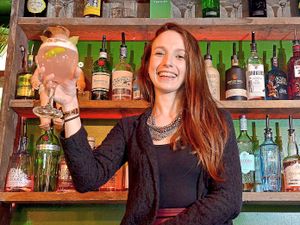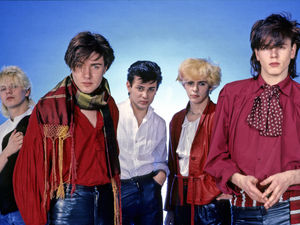Why is gin the toast of the town again?
On every corner in every major city they seem to be springing up – modern day gin palaces celebrating the resurgence of what was once known as Mother’s Ruin.

Even Her Majesty the Queen is known to enjoy a tipple of gin and Dubonnet.
And with more than 40 million bottles of the stuff sold in 2015/16, just what has brought about this spectacular rise in popularity?
It may be best known as Mother’s Ruin, but what has made gin make such a popular return to the glasses of both the young and old?
“You wouldn’t think about having rosemary gin or thyme in it, botanicals, citrus flavours. It’s such an easy-going drink that whatever your pallet, there’s a gin for you,” says Kelly Davis, events manager at Wolverhampton’s The Grain Store.
The bar has recently been transformed into Wolverhampton’s first Gin Emporium and Kitchen and opened it’s doors at the start of the month (May).
Paul Atkins, one of the owners of The Grain Store said: “We know that there has been a resurgence in popularity of gin – it’s seen as a very traditional British drink. This is why we have decorated the bar in a quirky traditionally British theme – graffiti of Her Majesty, Winston Churchill, the Union Jack.”
Now, on June 3, there is to be a Secret Gin Festival at the venue, with dozens of different types of gin on offer.
But the drink began life as a medical spirit in the early 1600s, used to give British troops fighting in the Low Countries during the Thirty Years’ War. It was called ‘Dutch courage’.
The Royals did their best to help gin take off. King Charles I set up the Worshipful Company of Distillers, where members had the sole right to distil spirits in London, Westminster and up to 21 miles beyond.
Farming also played its part, as gin was found to be a great way of using up surplus barley and corn.
Then, When King William III, otherwise known as William of Orange, came to the throne in 1689, he made a series of statutes meaning encouraging the distillation of English spirits. Thanks to William of Orange and according to his statues, anyone could now distil gin by just posting a notice in public and waiting 10 days. Gin was even In fact, gin was then distributed to workers as part of their wages and soon the volume sold daily exceeded that of the often more expensive beer and ale.
It was later sold in chemists throughout the nation and became so popular in the 1700s that the abuse of alcohol by the poor became a major problem – so the The Gin Act was brought in during September 1736.
The act made gin incredibly expensive, to try and deter the masses from drinking it. Riots broke out and the law was widely and openly broken.
Skip forward a few hundred years and specialist gin bars are opening up all over the place with people seeking out the latest flavour, taste and colour.
Kelly said: “I think what seems to happen is that certain drinks seem to take off and come back to fashion again. It has a rise in popularity in London then trickles down to the West Midlands. It’s so enjoyable because there are so many different varieties and combinations that you wouldn’t even think of.”
The drinks I sampled at the bar are the two most popular selections – the Sip Smith’s and Bedrock. Sip Smith’s which includes lemon, orange, raspberries and blackberries, says barman Daniel Hayward, 26, is ‘ideal for someone who doesn’t really know their gins – it doesn’t taste how you expect a G and T to taste, it’s really fruity and bright’. While The Bedrock includes Victorian rose lemonade,fresh basil leaves and raspberry with a blow-torched lemon foam. All a pretty long way from your standard G and T.
Manager of the venue, Rhiane Darley, 22, said: “Gin is so popular because it’s so fun. There’s a performance element to it when you’re blow-torching the top of the drinks – it makes it more of an experience and it makes you look forward to coming to work.”
Andrew Hulme, owner of micropub No. 7 Market Square, Stafford, said: “This is our second micropub – our first specialises in whiskies whilst this one, which we opened last July, has a top shelf packed with all varieties of gins. I think there has been a surge in British producers of gin in the last few years. All our gins are prepared with our own spices and herbs and have subtle differences to suit different tastes.
“It’s not just a women’s drink, although I believe traditionally, actually, it was once primarily a man’s tipple. Now we have all ages come in to try the different types and its incredible popular.”
In the UK’s second city, Birmingham, gin continues to take pubs and venues by storm.
Matt Sharp, general manager of Birmingham’s Gin Vault said: “It’s not just Mother’s Ruin anymore – we have people aged for 18 to in their 70s come in and ask for a particular type of gin. Long gone are the days of just Gordon’s or Bombay Sapphire.
“We opened nine months ago with 28 gins on offer. Now, because of popular demand, we have around 120. “I have a rule now that if more than five people ask for a particular type of gin, we stock it and see how it fares.We have different colours of gin – blue, yellow, pink, purple, some that change colour, and different flavours – strawberry, raspberry, peach, citrus, even menthol, as well as some packed with botanicals.
“I think the appeal is that it’s such an easy, light drink to enjoy that doesn’t really cause hangovers”– or so he claims.
In recent years, a total of four gin-only bars have opened in Birmingham city centre, with regular pubs and clubs stocking an increasing number of varieties, it looks as though the appetite for gin is as strong today as it was in the 1770s – although it’s more of a party than a riot.
Tickets for Wolverhampton’s first Secret Gin Festival are £5 and include a free gin. They are available at www.seetickets.com





